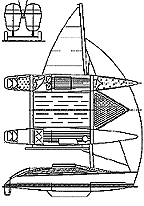X-Kat 23
Multihull pocket cruiserr
Still, cat fans remain adamant and designer Derek Kelsall of the United Kingdom has a series of folding or compressible cats that are taking direct aim at the trailerable multihull market. So fry up a big pan of "bubble and squeak," throw a couple of sausages on top and get into a British mood for this one.
This cat is produced in the UK and is the product of a prototype development program. The key to this design is the retracting glass and carbon connecting beams that allow the cat to be compressed. The sleeved beams slide into housings in the hulls, reducing the overall beam of the cat from 13 feet to 6.5 feet for trailering. The X-Kat team says that this system has an advantage over the folding trimaran in that it is simpler and quicker to activate.
I think the biggest advantage the cat has over the trimaran is the amount of deck space created by the connecting bridgedeck. Originally a trampoline-style bridgedeck was tried on the X-Kat, but this was dropped for the production model. The trampoline has been replaced with a folding, rigid floor. This is good. As comfortable as they tell you that trampolines are to lie on, they are hell to walk on.
Accommodations are minimal. After all, it's only a 23-foot boat. If two pillows at the head of a berth make it a double, then the brochure shows a double berth drawn aft in the starboard hull. I think it must be for very skinny people or for one guy with two heads. I consider 48 inches to be the absolute minimum width for a double berth; this double as drawn can be no wider than 29 inches. The accommodations in the hulls are accessed through gull-wing-style large hatches. With my 6-foot, 3-inch frame, I can't see myself being very comfortable on this boat in a cruising situation unless I was asleep. But that probably goes for most 23-foot monohulls as well.
The rig features a rotating mast and a loose-footed mainsail. Kelsall felt that the original rig is conservative and a taller rig is in the works for more performance-oriented owners. According to the written comments I have with this design, the boat will not match a trimaran for speed. Using all of the mainsail, we get an SA/D of 35. While this sounds high, you should keep in mind that most multihulls suffer from a preponderance of wetted surface. When boatspeed is less than half of the hull speed, the lion's share of drag is due to wetted surface.
This is certainly an interesting-looking package. All the photos I have of the 23 seem to show it sailing in a stern-down attitude. Even at the dock, the boat might be stern-heavy. The hulls are shapely and are developed from flat panels, making this design ideal for the home builder. Plans are available from the builder. You can also buy this boat in kit form, broken down in four stages from basic hulls, deck and beams kit to completed boat.
Pocket cruisers have a great tradition in England and if that's your style, then the X-Kat 23 would be worth considering. Write me c/o SAILING if you want my bubble-and-squeak recipe.

Comments